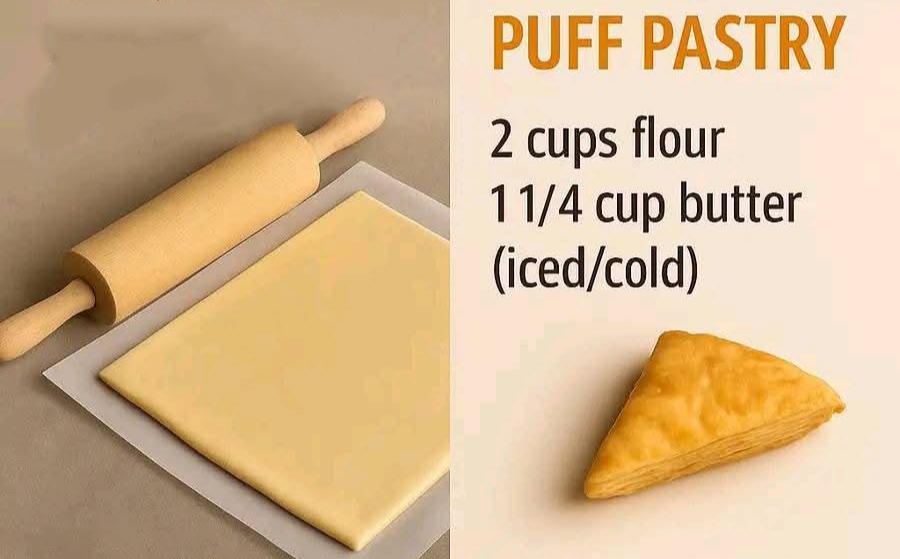Homemade Puff Pastry Dough vs. Pie Crust Dough
Puff pastry and pie crust are two foundational doughs in baking, each with unique textures and uses. Puff pastry is known for its light, flaky layers, achieved through a labor-intensive process of folding butter into the dough. This creates a crisp, airy result perfect for tarts, turnovers, and pastries. Pie crust, on the other hand, is tender and crumbly, designed to hold fillings without overwhelming them. While both require precision, puff pastry demands more patience due to its layered structure.
The choice between puff pastry and pie crust depends on the desired outcome. Puff pastry shines in delicate, buttery applications, while pie crust offers a sturdier base for custards or fruit fillings. Understanding their differences helps bakers select the right dough for their creations.
Ingredients for Puff Pastry Dough
- 2 cups all-purpose flour
- 1 ¼ cups cold unsalted butter
- Ice-cold water (as needed)
- Optional: pinch of salt
Instructions
Start by cutting the cold butter into small cubes and mixing it with the flour until crumbly.
Gradually add ice-cold water, a tablespoon at a time, until the dough comes together. Shape it into a rectangle, then roll it out and fold it into thirds.
Repeat this folding process 4-6 times, chilling the dough between folds to keep the butter cold. The layers will puff up during baking, creating the signature flakiness.
Variations
For a sweeter version, add a tablespoon of sugar to the dough. This works well for desserts like palmiers or fruit-filled pastries.
Another variation is using whole wheat flour for a nuttier flavor, though it may result in a slightly denser texture. For savory applications, incorporate herbs or grated cheese into the dough for added depth.
Gluten-free puff pastry is also possible by using a blend of rice flour and tapioca starch. However, the texture may differ slightly from traditional puff pastry.
Experimenting with different fats, like vegan butter or coconut oil, can cater to dietary preferences while still yielding flaky layers.
Tips
Keep all ingredients cold to prevent the butter from melting prematurely. This ensures the dough layers remain distinct.
Work quickly to maintain the dough’s temperature, and if it becomes too soft, refrigerate it for 15-20 minutes before continuing.
Rolling the dough evenly is crucial for consistent layers, so use a ruler to check thickness.
Avoid overworking the dough, as this can develop gluten and make it tough. A light touch preserves the delicate texture.
If the butter breaks through the dough during rolling, dust with flour and chill before proceeding. For best results, let the dough rest in the fridge for at least 30 minutes before baking.
How to Store
Unbaked puff pastry dough can be wrapped tightly in plastic and refrigerated for up to 3 days.
For longer storage, freeze the dough for up to 3 months. Thaw it overnight in the fridge before using to maintain its texture.
Baked puff pastry is best enjoyed fresh but can be stored in an airtight container at room temperature for 1-2 days.
Reheating in a low oven can help restore crispiness. Avoid refrigerating baked puff pastry, as moisture will soften the layers.
For pre-portioned dough, cut it into desired shapes before freezing.
This allows for easy use without thawing the entire batch. Label the packaging with the date to keep track of freshness.
Conclusion
Puff pastry dough is a versatile but demanding dough that rewards patience with incredible flakiness. Its layered structure sets it apart from pie crust, making it ideal for elegant pastries and tarts. Mastering the technique opens up a world of sweet and savory possibilities.
While pie crust is simpler to make, puff pastry’s unique texture is worth the effort for special occasions. With practice and attention to detail, homemade puff pastry can elevate your baking to new heights. Whether you’re crafting a classic mille-feuille or a savory cheese straw, this dough is sure to impress.
